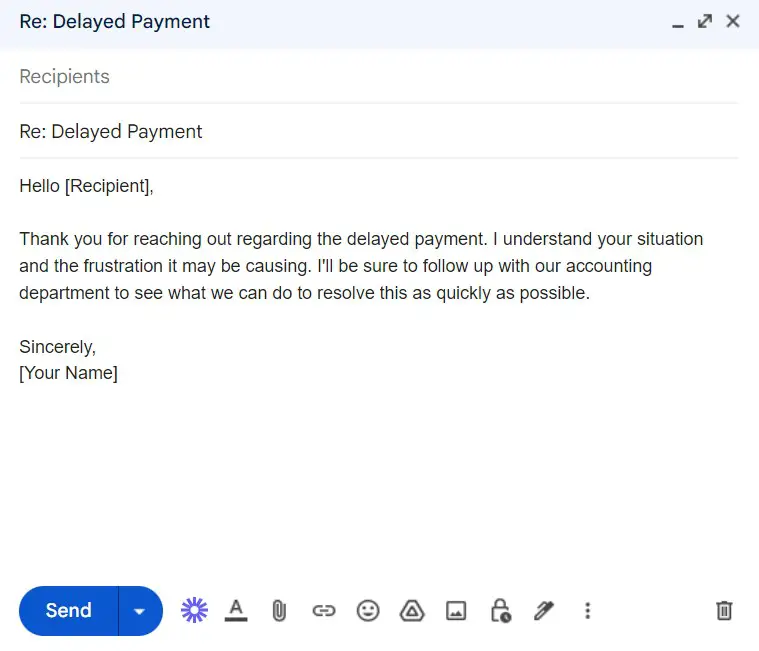Effective communication is crucial in any professional setting, especially when it comes to dealing with sensitive or difficult situations.
When reaching out to a colleague or client who is experiencing a challenge, using the phrase “I understand your situation” can go a long way in demonstrating empathy and building rapport.
But how do you use this phrase effectively in an email? Here are some tips and examples to guide you.
Contents
- How to Use the Phrase “I Understand Your Situation” in an Email
- Example Emails Using the Phrase “I Understand Your Situation”
- Example 1 – Subject: Regarding Your Recent Diagnosis
- Example 2 – Subject: Re: Delayed Payment
- Example 3 – Subject: Ideas for Virtual Team Building
- Example 4 – Subject: Support During Your Transition
- Example 5 – Subject: Re: Recent Staffing Changes
- Example 6 – Subject: Addressing Your Concerns
- Example 7 – Subject: Re: Rescheduling the Meeting
- Example 8 – Subject: Offering Support During a Difficult Project
- Example 9 – Subject: Re: Request for Additional Time
- Example 10 – Subject: Addressing Your Concerns
- Alternative Ways of Saying “I Understand Your Situation” in an Email
How to Use the Phrase “I Understand Your Situation” in an Email
- Begin with a professional greeting, such as “Dear [Recipient],” or “Hello [Recipient],”
- Acknowledge the situation that the recipient is facing, using language that is sensitive and understanding. For example, “I’m sorry to hear about the difficulties you’re experiencing,” or “I understand that you’re going through a challenging time right now.”
- Use the phrase “I understand your situation” to demonstrate empathy and show that you are actively listening and engaging with the recipient. For example, “I want you to know that I understand your situation and am here to support you in any way I can.”
- Follow up with a specific offer of assistance or a suggestion for next steps, if appropriate. For example, “If you need any additional resources or support, please don’t hesitate to let me know,” or “Perhaps we could schedule a time to discuss this further and brainstorm some potential solutions.”
- End the email with a professional closing, such as “Best regards,” “Sincerely,” or “Thank you,” followed by your name and contact information.
Check out how to use these tips in real email examples below.
Example Emails Using the Phrase “I Understand Your Situation”
Example 1 – Subject: Regarding Your Recent Diagnosis
Dear [Recipient],
I wanted to reach out and express my condolences for the news about your recent diagnosis. I understand your situation must be difficult, and I want you to know that I’m here to offer any support I can during this time. Please let me know if there’s anything I can do to help.
Best regards,
[Your Name]
Example 2 – Subject: Re: Delayed Payment
Hello [Recipient],
Thank you for reaching out regarding the delayed payment. I understand your situation and the frustration it may be causing. I’ll be sure to follow up with our accounting department to see what we can do to resolve this as quickly as possible.
Sincerely,
[Your Name]
Example 3 – Subject: Ideas for Virtual Team Building
Dear [Recipient],
I know that keeping your team connected and engaged in a virtual environment can be a challenge. I understand your situation and would be happy to offer some suggestions for virtual team building activities that may help. Let me know if you’re interested.
Best,
[Your Name]
Example 4 – Subject: Support During Your Transition
Hello [Recipient],
I understand your situation and the difficulties that can arise during a period of transition. As your manager, I’m here to offer any support or guidance you may need as you navigate this change. Please don’t hesitate to reach out if you have any questions or concerns.
Best regards,
[Your Name]
Example 5 – Subject: Re: Recent Staffing Changes
Dear [Recipient],
I wanted to follow up on our recent conversation about the staffing changes within the company. I understand your situation and the impact these changes may have on your workload and morale. Please know that I’m here to support you during this time and we can work together to find ways to mitigate any negative effects.
Thank you,
[Your Name]
Example 6 – Subject: Addressing Your Concerns
Hello [Recipient],
I appreciate you reaching out and expressing your concerns. I understand your situation and want to assure you that we take your feedback seriously. Let’s schedule a time to discuss this further so that we can come up with a solution that addresses your concerns and meets everyone’s needs.
Best regards,
[Your Name]
Example 7 – Subject: Re: Rescheduling the Meeting
Dear [Recipient],
I’m sorry to hear that the original meeting time no longer works for you. I understand your situation and the importance of finding a time that works for everyone. Let’s coordinate to find a new date and time that works for all parties involved.
Thank you,
[Your Name]
Example 8 – Subject: Offering Support During a Difficult Project
Hello [Recipient],
I know that the project we’re working on together has been challenging, and I understand your situation and the stress it may be causing. I’m here to offer any support or resources you may need to help us move forward and achieve our goals.
Sincerely,
[Your Name]
Example 9 – Subject: Re: Request for Additional Time
Dear [Recipient],
I received your request for additional time to complete the project. I understand your situation and the need for flexibility. Let’s discuss this further to ensure that we come up with a plan that meets everyone’s expectations and deadlines.
Best regards,
[Your Name]
Example 10 – Subject: Addressing Your Concerns
Hello [Recipient],
Thank you for sharing your feedback and concerns with me. I understand your situation and the importance of addressing these issues in a timely and effective manner. Let’s work together to find a solution that meets everyone’s needs and ensures a positive outcome.
Thank you,
[Your Name]
Alternative Ways of Saying “I Understand Your Situation” in an Email
If you’re looking for alternative ways to convey empathy and understanding in an email, here are a few additional phrases you can use:
- “I hear what you’re saying and appreciate your perspective.”
- “I’m sorry to hear that you’re going through this.”
- “Thank you for bringing this to my attention. I want to make sure we address this in the best way possible.”
- “I understand the challenges you’re facing and want to help in any way I can.”
- “I appreciate you sharing this with me. Let’s work together to find a solution that works for everyone.”
Using these phrases can help you show empathy and build trust with your colleagues or clients, while also demonstrating your commitment to finding solutions and resolving issues in a positive and constructive way.


